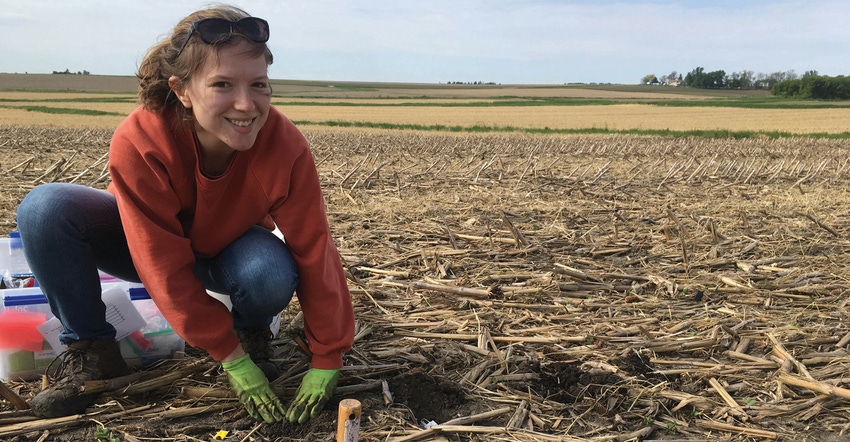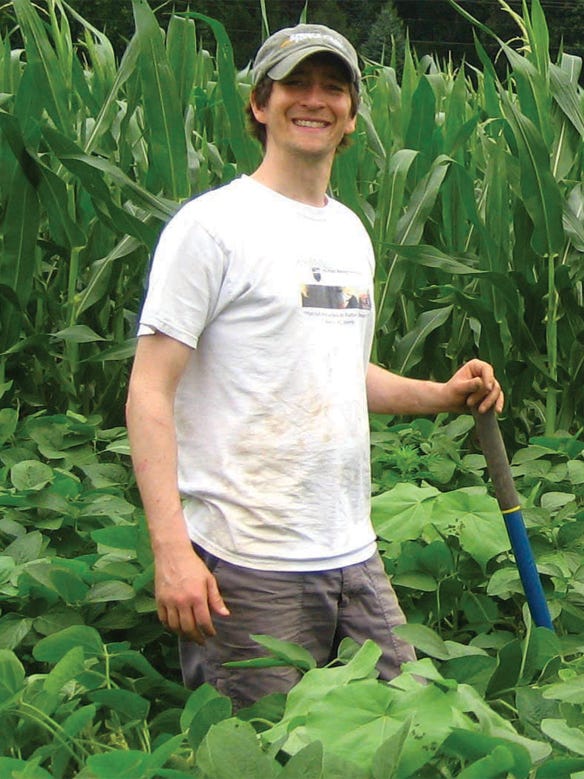September 25, 2018

By Stefan Gailans
In summer 2016, graduate student David Weisberger, who was a member of Practical Farmers of Iowa, connected PFI staff with an incoming Iowa State University faculty member, Dr. Marshall McDaniel. The match proved natural: Both PFI and McDaniel were equally curious about how agricultural practices affect soil health.
McDaniel, who now teaches and researches soil fertility and ecology in the department of agronomy, was also keen to involve farmers in the research he was starting with his lab team. “I’ve always wanted to get into citizen science. It’s a great way to educate, engage citizens in science and conservation, and it’s just plain fun,” he says.
During the initial meeting with McDaniel, PFI listed the numerous soil health tests and assessments that were being offered to farmers. From past experiences with these new tests, PFI knew farmers using them were often getting back confusing — though interesting — results, and the tests could be costly. With that in mind, PFI and McDaniel agreed to brainstorm ideas for a research project that would investigate soil health while also involving farmers in a fun and easy way.
Path to a new PFI study
Not long after that meeting, McDaniel found a study by a group of researchers from the University of Utrecht in the Netherlands led by Dr. Joost A. Keuskamp that measured how quickly tea bags took to decompose when buried in soil.
Tea is an organic material, not unlike the plant residue or other organic matter present in our soils. And just as the carbon-to-nitrogen ratio of the organic matter in our soils influences how long it takes for soil microbes to break down that organic matter, the same can be said for tea. Green tea has a relatively low C:N ratio (like alfalfa hay), whereas red tea has a relatively high C:N ratio (like corn stover).
Organic material with a lower C:N ratio decomposes more quickly than material with a higher C:N ratio. This proved true in the European study. The researchers collected soil from a forest, brought it back to their lab and buried red and green tea bags in it. After only 30 days of incubation, just 33% of the green tea’s mass remained, while over 60% of the red tea’s mass remained after 130 days of incubation.
From this study, and some of his own prior research, McDaniel devised a hypothesis: decomposition of tea with a high C:N ratio, like the red tea, is limited by soil microbial activity and the resources available to those microbes (carbon and nitrogen in the soil).
In other words, healthy soils that are teeming with microbial life and have an abundance of resources are better able to break down organic material (tea), regardless of its C:N ratio, than less healthy soil. In the poorer-quality soils, meanwhile, the green tea should decompose readily, but the red tea should not.
McDaniel concluded that comparing green and red tea bags buried in a field or experimental strip could be used to determine a soil health index. The green tea could be considered the “baseline” — it will decompose at roughly the same rate in a healthy and unhealthy soil. The red tea is the “indicator” that should decompose more in a healthy soil than an unhealthy soil.
If the amount of both the green and red tea diminished substantially after a given amount of time, the soil would be considered healthy. If only the green tea diminished, but the red tea did not, the soil is of poorer health.
Cover crops boost soil health
In fall 2016, PFI recruited a few farmers to seed replicated strips of a cereal rye cover crop into soybean stubble while leaving an equal number of strips bare, with no cover crop. The objectives were twofold: determine the effect of the cover crop on the 2017 corn crop’s yield, and detect any effect of the cover crop on the soil. Enter the tea.
McDaniel, and his graduate student, Teresa Middleton, traveled to these on-farm research sites in June 2017 to bury sets of green and red tea bags in the replicated cover crop and no-cover strips.
“I really enjoyed working one on one with the farmers and learning about what was important to them,” Middleton says. “It was great to see such enthusiasm for research from the PFI community.”
Throughout the summer, Middleton returned to the farms to retrieve the tea bags from the soil while also collecting soil moisture and temperature data. The tea bags were brought back to McDaniel’s lab at ISU, dried and weighed to determine how much tea had decomposed.
Across all nine sites in the study, the cover crop strips scored better on the soil health index by 11% using the tea bag approach. The cover crop strips scored closer to one on the soil health index scale of zero to 1.
A score closer to 1 indicates a healthier soil because there’s more microbial activity working to decompose organic materials (in this case, the tea).
“It did not seem to matter how long cover crops have been in place at these sites, whether it was one or 15 years,” McDaniel says. Other interesting findings from Middleton’s measurements at the farms indicate that the soil temperature throughout the summer was not affected by the cover crop, but that on average, the cover crop resulted in increased soil moisture at certain times of the year.
Tom Christian, who farms near Roland in Story County, was one of the cooperators involved in the study. At his farm, the green tea decomposed at nearly the same rate where there was a cover crop and no cover.
The red tea, however, decomposed more in the cover crop strips than in the no-cover strips. On the soil health index scale of zero to 1, the cover crop strips at Christian’s farm scored 10 points higher than the no-cover strips (0.45 vs. 0.35).
Need simple, useful soil health test
“As a beginning farmer, I was very excited to participate in this study, and I found the results to be quite promising,” Christian says. “I have many crop seasons ahead of me, and I’m always looking for ways to make long-term improvements to the most important asset in our farming operation: the soil. I’m confident that continued research will result in cover crop systems that provide both short-term yield gains and long-term environmental benefits.”
Eventually, McDaniel’s team wants to produce a simple and useful soil health test that farmers could use on their own. “The appeal of using tea bags for such a soil health assessment is they’re inexpensive and readily available,” McDaniel says.

SOIL DOCTOR: Marshall McDaniel teaches and researches soil fertility at ISU’s agronomy department. He wants to develop a simple, useful soil health test that farmers could use on their own.

That appeals to farmers like Christian. “I like the idea of an inexpensive soil health test that can provide me with benchmarks on our farms,” he says. “Coupled with the results of a typical soil sample, I see the tea bag system as a powerful tool in identifying and treating problem areas within a field.”
At this point, there’s still plenty of work to be done to make this a consistent and reliable soil test. Stay tuned for results of this new soil health test in future PFI research.
Gailans is research and field crops director for PFI located in Ames.
You May Also Like




